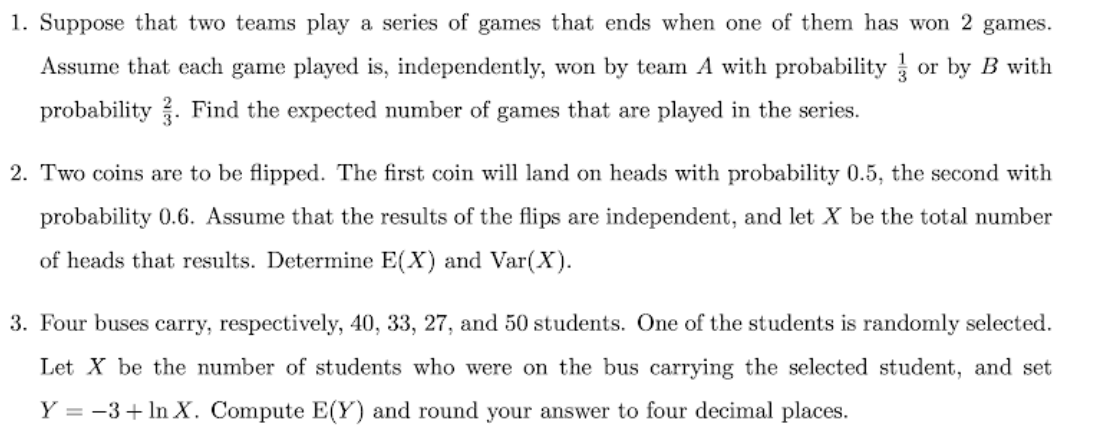1. Suppose that two teams play a series of games that ends when one of them has won 2 games. Assume that each game played is, independently, won by team A with probability or by B with probability. Find the expected number of games that are played in the series. 2. Two coins are to be flipped. The first coin will land on heads with probability 0.5, the second with probability 0.6. Assume that the results of the flips are independent, and let X be the total number
1. Suppose that two teams play a series of games that ends when one of them has won 2 games. Assume that each game played is, independently, won by team A with probability or by B with probability. Find the expected number of games that are played in the series. 2. Two coins are to be flipped. The first coin will land on heads with probability 0.5, the second with probability 0.6. Assume that the results of the flips are independent, and let X be the total number
A First Course in Probability (10th Edition)
10th Edition
ISBN:9780134753119
Author:Sheldon Ross
Publisher:Sheldon Ross
Chapter1: Combinatorial Analysis
Section: Chapter Questions
Problem 1.1P: a. How many different 7-place license plates are possible if the first 2 places are for letters and...
Related questions
Question
I2

Transcribed Image Text:1. Suppose that two teams play a series of games that ends when one of them has won 2 games.
Assume that each game played is, independently, won by team A with probability or by B with
probability. Find the expected number of games that are played in the series.
2. Two coins are to be flipped. The first coin will land on heads with probability 0.5, the second with
probability 0.6. Assume that the results of the flips are independent, and let X be the total number
of heads that results. Determine E(X) and Var(X).
3. Four buses carry, respectively, 40, 33, 27, and 50 students. One of the students is randomly selected.
Let X be the number of students who were on the bus carrying the selected student, and set
Y = -3 + ln X. Compute E(Y) and round your answer to four decimal places.
Expert Solution
This question has been solved!
Explore an expertly crafted, step-by-step solution for a thorough understanding of key concepts.
Step by step
Solved in 4 steps

Recommended textbooks for you

A First Course in Probability (10th Edition)
Probability
ISBN:
9780134753119
Author:
Sheldon Ross
Publisher:
PEARSON


A First Course in Probability (10th Edition)
Probability
ISBN:
9780134753119
Author:
Sheldon Ross
Publisher:
PEARSON
